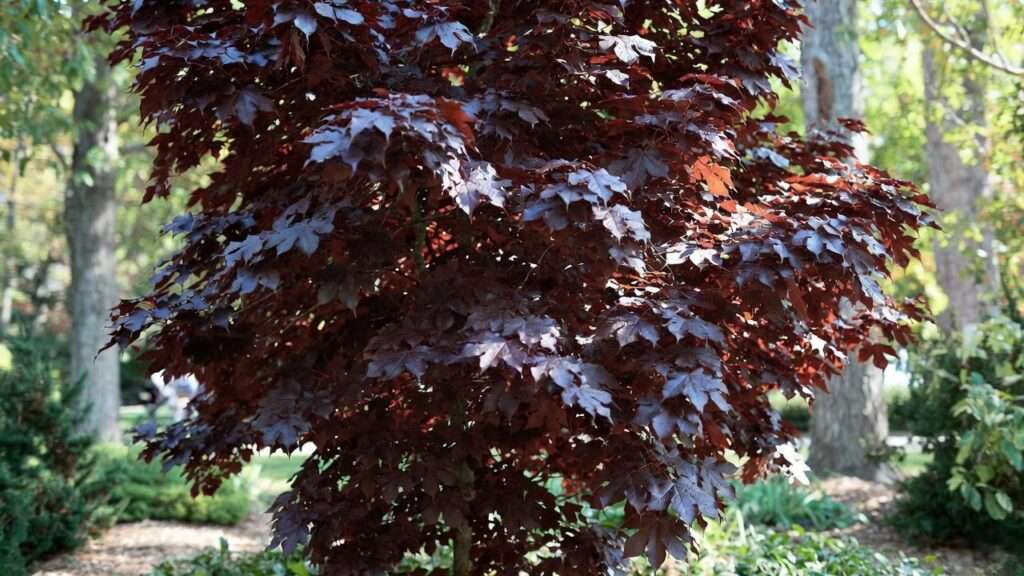Imagine your yard transformed by a majestic tree with deep red-purple leaves that glow like a sunset, captivating every passerby. The Crimson King Maple Tree is that showstopper, a favorite among homeowners and landscapers for its bold color and commanding presence. But its beauty comes with a responsibility: proper care is essential to keep this iconic tree thriving. Whether you’re a novice gardener or a seasoned arborist, this comprehensive guide, crafted with insights from certified horticulturists and decades of tree care experience, will equip you with everything you need to plant, nurture, and protect your Crimson King Maple. From choosing the perfect spot to tackling pests, we’ll ensure your tree remains a vibrant centerpiece for years to come. 🌿
1. Understanding the Crimson King Maple Tree 🌲
What Makes the Crimson King Maple Tree Special? ✨
The Crimson King Maple, scientifically known as Acer platanoides ‘Crimson King,’ is a standout cultivar of the Norway Maple, prized for its striking foliage. Its leaves, a deep red-purple from spring to fall, create a dramatic contrast in any landscape. Growing up to 40–50 feet tall and 25–35 feet wide, this deciduous tree offers ample shade and boosts curb appeal, often increasing property value. It thrives in USDA Hardiness Zones 3–7, making it adaptable to a range of climates, from chilly northern regions to temperate southern areas.
Unlike other maples, the Crimson King’s foliage retains its rich hue throughout the growing season, rather than turning vibrant only in autumn. This makes it a top choice for ornamental landscaping, whether as a focal point in a front yard or a stately shade tree in a park. Its dense canopy also provides habitat for birds, adding ecological value to its aesthetic appeal.
History and Origins 📜
Developed in Europe in the 1930s, the Crimson King Maple was bred from the Norway Maple to emphasize its vivid foliage. It quickly gained popularity in North America for its adaptability and low maintenance compared to other ornamental trees. Unlike the Sugar Maple (Acer saccharum), known for syrup production, or the Red Maple (Acer rubrum), with its fleeting fall colors, the Crimson King offers year-round visual impact with minimal fuss, provided it’s cared for properly.
2. Planting Your Crimson King Maple Tree 🌱
Choosing the Perfect Location 📍
The success of your Crimson King Maple starts with the right planting site. This tree prefers well-drained, slightly acidic to neutral soil (pH 6.0–7.0). Test your soil with a home kit or consult a local extension service to ensure compatibility. Full sun is ideal for the richest leaf color, though the tree tolerates partial shade. Aim for at least six hours of direct sunlight daily.
Space is critical: at maturity, the Crimson King’s broad canopy needs room to spread. Plant at least 15–20 feet from buildings, driveways, or underground utilities to avoid root interference. Poor drainage is a common pitfall—standing water can lead to root rot, a leading cause of tree failure. If your yard has heavy clay soil, consider raised planting beds or amending the soil with organic matter like compost.
Step-by-Step Planting Guide 🛠️
- Timing: Plant in early spring or fall when temperatures are cool, allowing roots to establish before extreme heat or cold.
- Site Preparation: Test soil drainage by digging a 12-inch hole, filling it with water, and ensuring it drains within 24 hours. Amend soil with compost or aged manure to improve fertility and structure.
- Digging the Hole: Make the hole twice as wide as the root ball but no deeper. This encourages lateral root growth.
- Planting: Place the tree so the root flare (where roots meet the trunk) sits slightly above ground level. Backfill with native soil, tamping gently to remove air pockets.
- Watering: Water deeply after planting, providing 10–15 gallons to settle the soil.
- Mulching: Apply a 2–3 inch layer of organic mulch (e.g., wood chips or bark) around the base, keeping it 2 inches from the trunk to prevent rot.
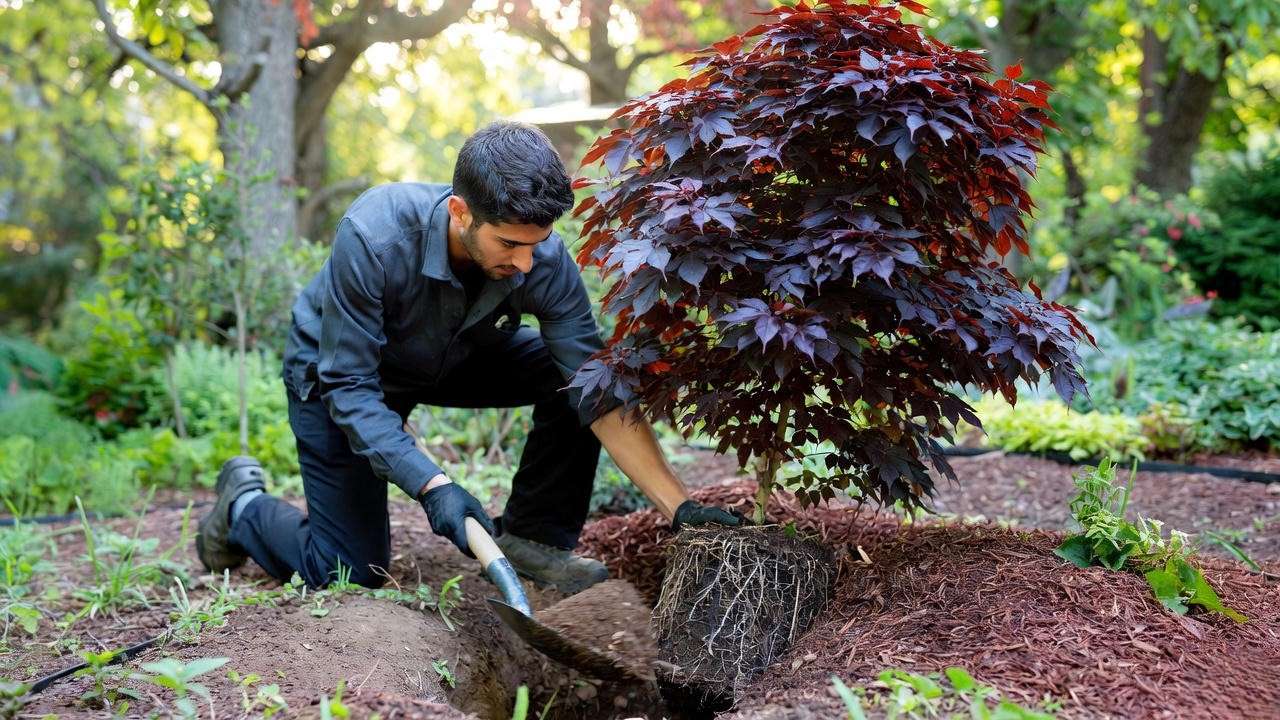
Expert Tip 💡
Arborist Sarah Thompson, with 15 years of experience, advises: “Before planting, perform a simple drainage test. Fill a hole with water and check it after 12 hours. If it’s still full, choose a different spot or improve drainage with gravel and compost to save your Crimson King from root rot.”
3. Essential Care Tips for a Thriving Crimson King Maple 🌿
Watering and Irrigation Needs 💧
Proper watering is the backbone of Crimson King Maple care. Young trees (1–3 years old) need consistent moisture to establish roots. Water deeply once a week, providing 10–15 gallons, especially during dry spells. Mature trees are more drought-tolerant but benefit from supplemental watering during prolonged heatwaves.
Watch for signs of trouble: yellowing leaves or wilting may indicate underwatering, while soggy soil or leaf drop suggests overwatering. In summer, increase watering frequency, especially in sandy soils. In winter, reduce watering to prevent root saturation. A soaker hose or drip irrigation system ensures even moisture without runoff.
Fertilizing for Optimal Growth 🌼
Fertilizing supports healthy growth and vibrant foliage. In early spring, apply a slow-release, balanced fertilizer (e.g., 10-10-10 NPK) around the drip line—the area beneath the outermost branches. For a 3-inch trunk diameter, use 1–2 pounds of fertilizer, spread evenly and watered in thoroughly.
Avoid over-fertilizing, which can cause excessive leaf growth at the expense of root development or lead to leaf burn. Soil testing every 2–3 years helps tailor nutrient applications. Organic options like composted manure or fish emulsion are excellent for eco-conscious gardeners.
Pruning and Shaping ✂️
Pruning maintains the Crimson King’s structure and health. The best time to prune is late winter or early spring, before sap flow begins. Remove dead, damaged, or crossing branches to improve air circulation and reduce disease risk. Use clean, sharp tools—a bypass pruner for small branches and a pruning saw for larger ones—to make clean cuts just outside the branch collar.
For young trees, shape the canopy by selecting a central leader (main trunk) and removing competing branches. Avoid heavy pruning, as it stresses the tree. Regular maintenance pruning every 2–3 years keeps the tree tidy and prevents structural issues.
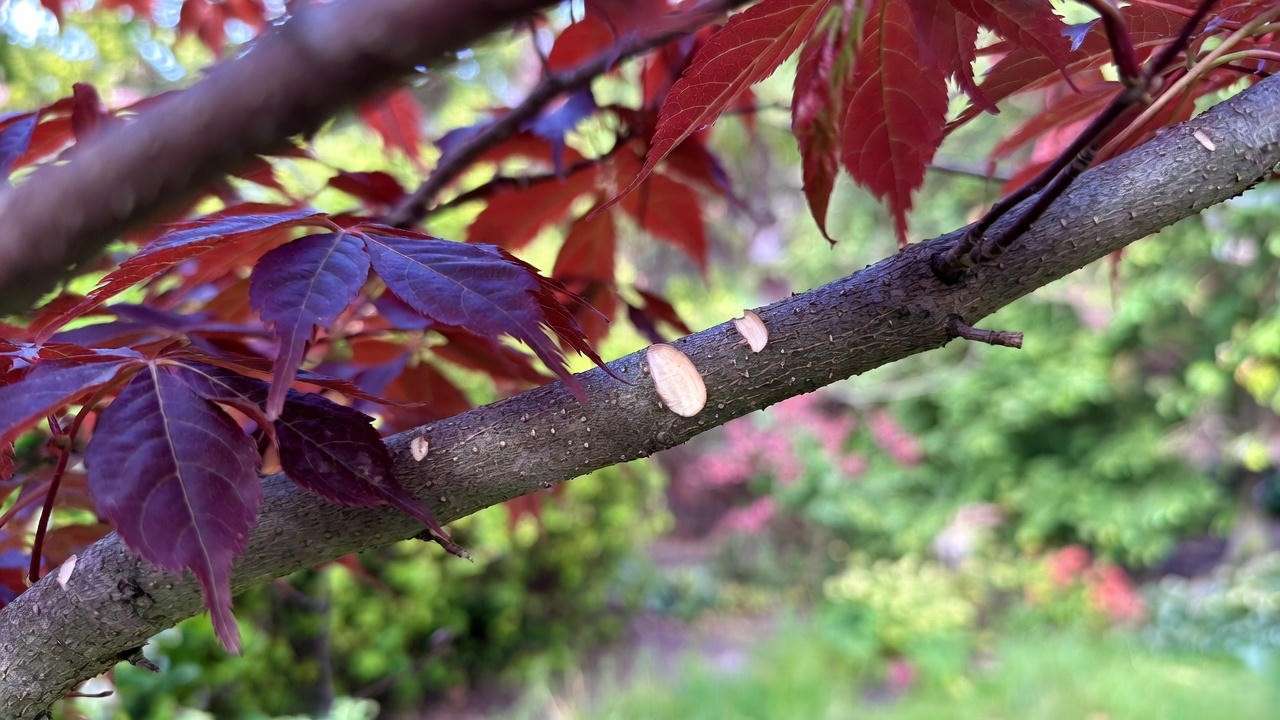
Expert Insight 🧠
Certified arborist Dr. James Carter notes, “Strategic pruning not only enhances the Crimson King’s aesthetic appeal but also extends its lifespan. Focus on removing weak or inward-growing branches to create a strong, open canopy that withstands wind and snow.”
4. Protecting Your Crimson King Maple from Pests and Diseases 🐞
Common Pests to Watch For 🕷️
The Crimson King Maple is relatively hardy but can attract pests like aphids, scale insects, and spider mites. Aphids leave a sticky residue (honeydew) and cause leaf curling. Scale appears as small, waxy bumps on branches, while spider mites create fine webbing and stippled leaves.
Control pests with organic methods first: spray neem oil or insecticidal soap weekly until infestations subside. For severe cases, consult a professional for targeted chemical treatments. Prevent issues by maintaining tree vigor through proper watering and fertilization, as stressed trees are more susceptible.
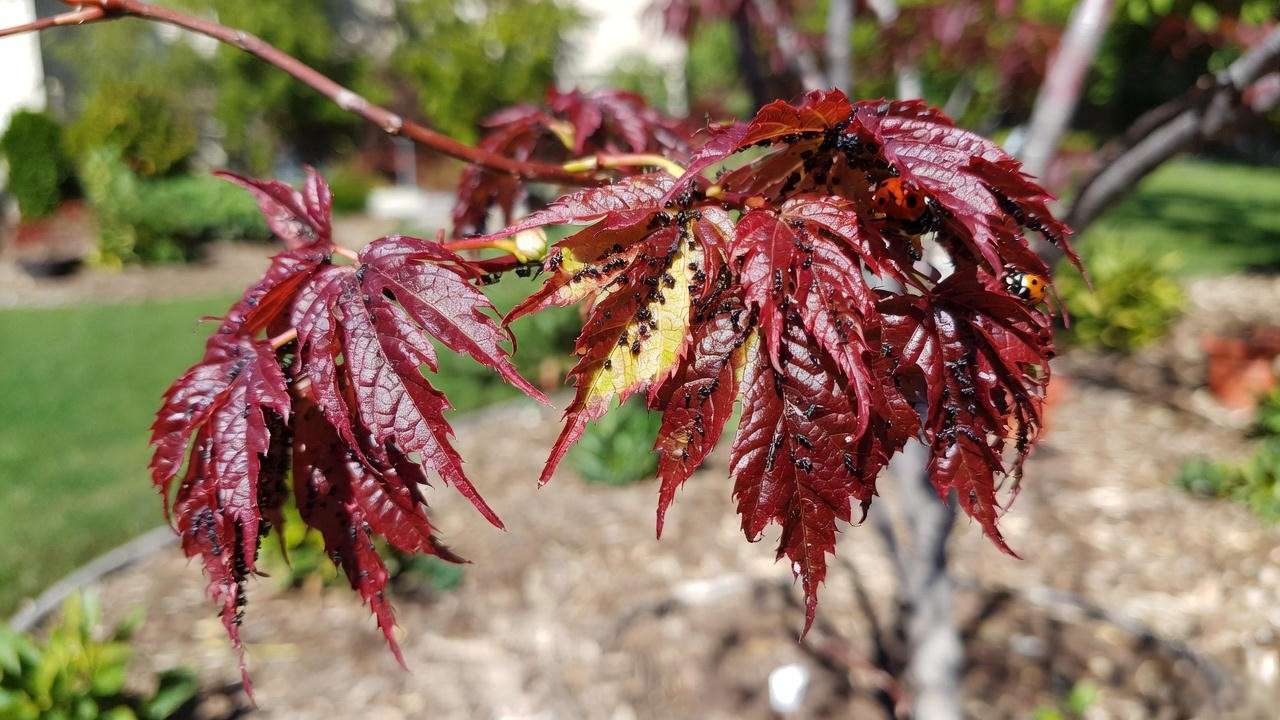
Diseases and How to Manage Them 🩺
Common diseases include Verticillium wilt, tar spot, and anthracnose. Verticillium wilt, caused by a soil-borne fungus, leads to wilting branches and yellowing leaves. Tar spot appears as black spots on leaves, while anthracnose causes brown, irregular patches.
For Verticillium wilt, prune affected branches and improve soil drainage. Tar spot and anthracnose are managed by raking up fallen leaves to reduce fungal spores and applying fungicides in early spring if needed. Ensure good air circulation by spacing trees properly and thinning dense canopies.
Real-Life Example 📖
In 2023, Ohio homeowner Lisa M. noticed her Crimson King Maple’s leaves curling and covered in sticky residue. After identifying an aphid infestation, she used neem oil sprays and introduced ladybugs, a natural predator. Within weeks, the tree recovered, showcasing the power of integrated pest management.
5. Seasonal Care for Year-Round Beauty 🍂
Spring and Summer Care 🌞
Spring is a critical time for your Crimson King Maple as it emerges from dormancy. Monitor new growth for signs of vigor, such as bright, evenly colored leaves. Water young trees weekly, ensuring the soil stays moist but not waterlogged. For established trees, check soil moisture during heatwaves and provide 10–15 gallons of water if the top 2 inches of soil feel dry.
Mulching is key in summer to retain moisture and keep roots cool. Apply a 2–3 inch layer of organic mulch, such as shredded bark or wood chips, extending it to the drip line but avoiding contact with the trunk. Inspect regularly for pests like aphids or spider mites, which thrive in warm weather, and address them promptly with organic sprays.
Fall and Winter Care ❄️
As autumn arrives, the Crimson King Maple’s leaves may deepen in hue before dropping. Rake up fallen leaves to prevent fungal diseases like tar spot from overwintering. Reduce watering as the tree enters dormancy, but ensure young trees receive occasional deep watering if rainfall is scarce.
In winter, protect young trees from sunscald—a condition where fluctuating temperatures cause bark cracking—by wrapping trunks with tree wrap or burlap. For regions with heavy snow, gently shake branches to remove snow buildup and prevent breakage. Prune in late winter to remove weak or damaged branches, preparing the tree for spring growth.
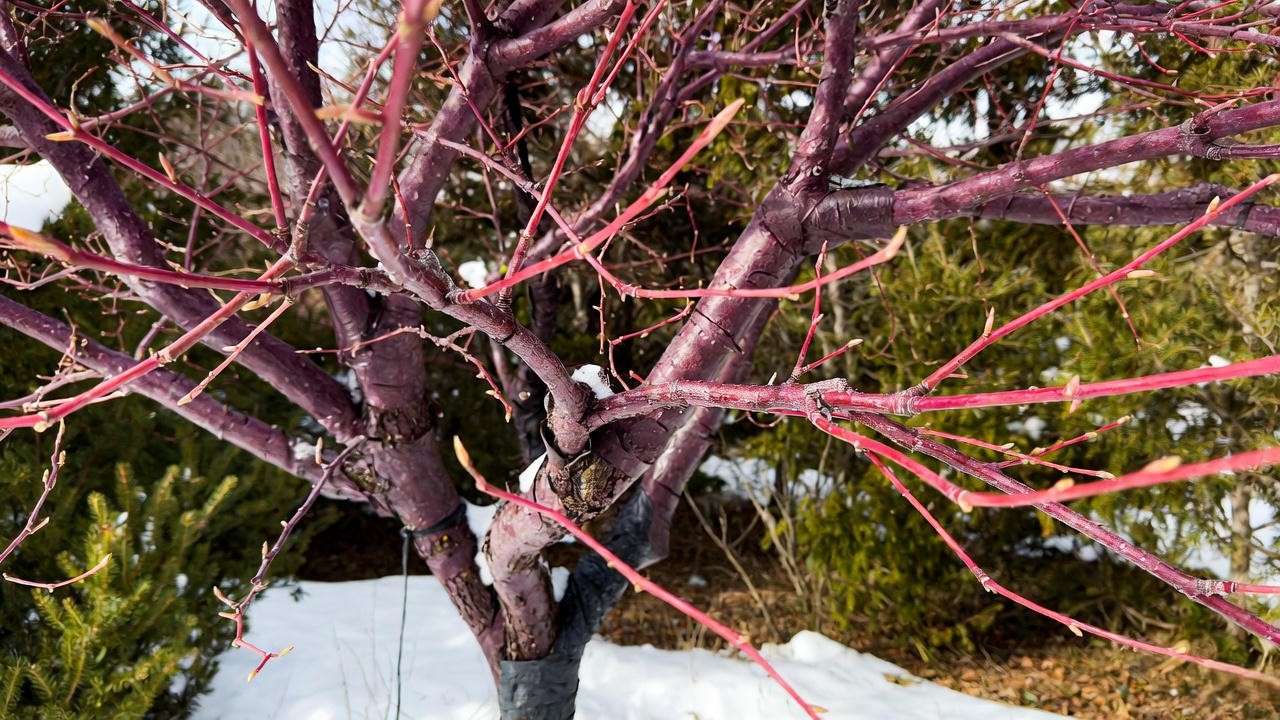
Seasonal Checklist ✅
To simplify care, here’s a quick seasonal checklist for your Crimson King Maple:
- Spring: Test soil, fertilize, and prune lightly; monitor for new growth and pests.
- Summer: Water deeply, mulch, and inspect for insects or leaf scorch.
- Fall: Rake leaves, reduce watering, and check for disease signs.
- Winter: Wrap young trunks, clear snow from branches, and plan pruning.
Downloadable Tip: Save this checklist as a PDF from our website to keep your Crimson King Maple care on track year-round! 📋
6. Troubleshooting Common Problems 🔧
Why Is My Crimson King Maple Struggling? 🤔
Even with diligent care, your Crimson King Maple may face challenges. Here are common issues and solutions:
- Leaf Scorch: Brown, crispy leaf edges often result from drought or intense sun. Increase watering and provide afternoon shade with companion plants or temporary shade cloth.
- Slow Growth: Poor soil fertility or compacted roots may be the culprit. Test soil nutrients and aerate the root zone with a garden fork, then apply a balanced fertilizer.
- Premature Leaf Drop: This can signal overwatering, pests, or disease. Check soil drainage, inspect for insects, and look for fungal spots to diagnose the cause.
To troubleshoot, start by observing symptoms: Are leaves discolored? Is growth stunted? Use a process of elimination—check water, soil, and pests—before taking action. If problems persist, a soil test or professional consultation can pinpoint issues.
When to Call an Arborist 📞
Some issues require expert intervention. Call a certified arborist if you notice:
- Severe branch dieback or wilting, indicating possible Verticillium wilt.
- Structural damage, such as cracked limbs or leaning trunks, which pose safety risks.
- Persistent decline despite corrective measures.
Find a reputable arborist through the International Society of Arboriculture (ISA) or local extension services. Ask for certifications and references to ensure quality care.
7. Enhancing Your Landscape with the Crimson King Maple 🌸
Design Ideas for Stunning Landscapes 🏡
The Crimson King Maple’s bold foliage makes it a versatile addition to any landscape. Use it as:
- Focal Point: Plant it in a front yard to draw attention, surrounded by low-growing perennials like hostas or daylilies for contrast.
- Shade Tree: Position it in a backyard to create a cool, inviting space for outdoor gatherings.
- Street Tree: Line driveways or sidewalks, ensuring enough space to avoid root conflicts with pavement.
Pair it with companion plants that complement its color, such as white hydrangeas, golden ornamental grasses, or evergreen shrubs like boxwood. For hardscaping, integrate the tree with stone pathways or a circular patio beneath its canopy, creating a cohesive garden design.
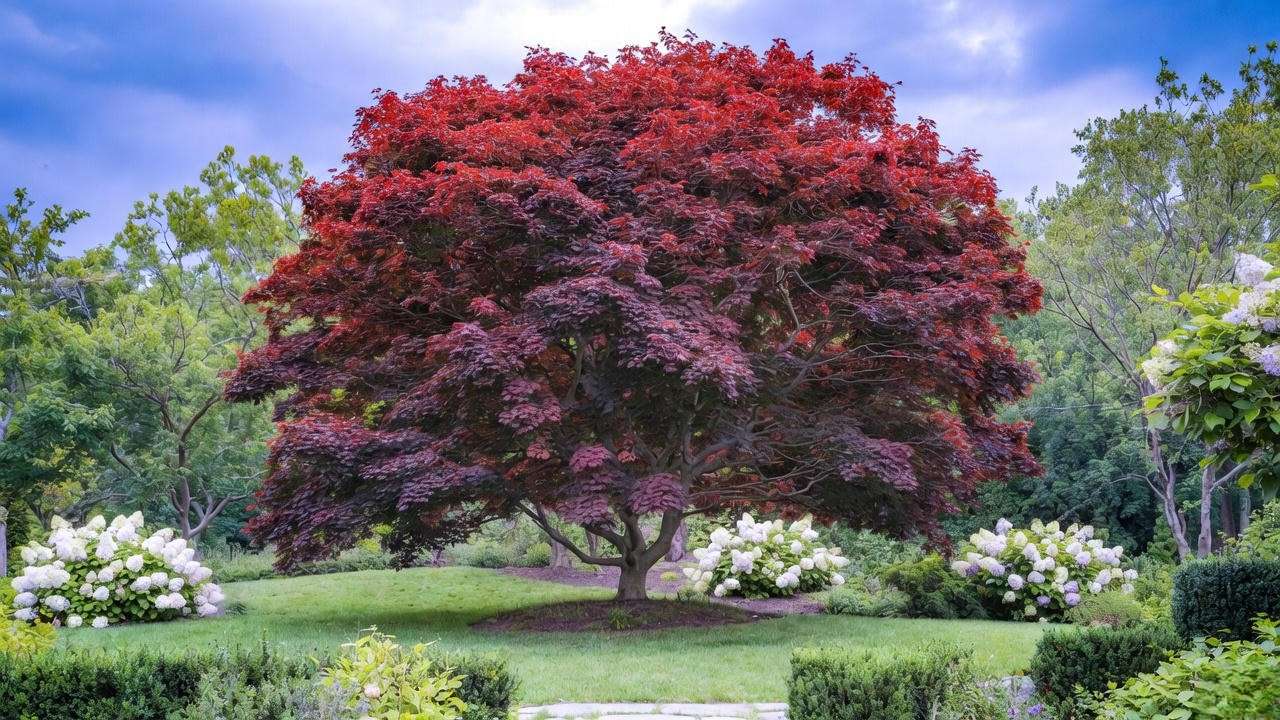
Before-and-After Example 🖼️
Consider Jane, a Virginia homeowner who transformed her bland backyard with a Crimson King Maple. Before, her yard lacked structure and color. After planting the maple as a centerpiece, surrounded by a bed of lavender and decorative grasses, the space became a vibrant oasis. The tree’s red-purple leaves contrasted beautifully with the soft purples and greens, earning compliments from neighbors and boosting her home’s curb appeal.
8. FAQs About Crimson King Maple Tree Care ❓
- Q1: How fast does a Crimson King Maple grow?Answer: It grows moderately at 1–2 feet per year under ideal conditions, reaching maturity in 20–30 years.
- Q2: Can it thrive in urban environments?Answer: Yes, it tolerates pollution and compacted soil better than many trees, but choose well-drained sites and monitor for stress.
- Q3: How do I prevent leaf scorch in hot climates?Answer: Water deeply, mulch generously, and plant companion shrubs to provide afternoon shade.
- Q4: Is the Crimson King Maple invasive?Answer: Unlike some Norway Maples, the Crimson King is less invasive but can self-seed. Remove seedlings to prevent unwanted spread.
- Q5: What’s the lifespan of a Crimson King Maple?Answer: With proper care, it can live 60–80 years, becoming a legacy tree for your property.
9. Conclusion: Your Path to a Thriving Crimson King Maple 🌟
The Crimson King Maple Tree is more than a stunning addition to your landscape—it’s a long-term investment in beauty and shade. By choosing the right planting site, maintaining consistent watering, fertilizing wisely, pruning strategically, and protecting against pests and diseases, you’ll ensure your tree thrives for decades. Use the seasonal checklist to stay organized, and don’t hesitate to consult an arborist for complex issues. Ready to make your Crimson King Maple the star of your yard? Share your journey in the comments, download our care checklist, or reach out to a local tree expert for personalized advice. Here’s to a vibrant, healthy tree that future generations will admire! 🌳

